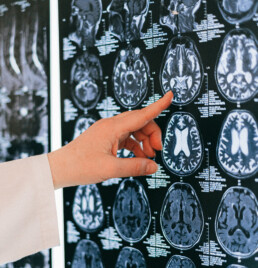Treating neuropathic pain, often characterized by intense shooting, stabbing, or burning pain, is a major healthcare challenge. It is thought that the dynamic organization of neural networks is affected in patients with chronic pain.
Written by:
Quinn Pauli
Edited by:
Georgia Hadjis
Electrical activity may be used as a potential diagnostic and therapeutic to target these affected networks, referred to as ‘brain microstates’. Electrical activity can be measured using magnetoencephalography (MEG), a sensitive imaging tool with high temporal resolution that can identify neuronal oscillations in the alpha frequency band, which is thought to be a potential neuromarker of abnormal brain activity in chronic pain.In the present study, UTCSP members Dr. Camille Fauchon and Dr. Andrew Kim, along with Dr. Karen Davis, Dr. Anuj Bhatia and colleagues applied a Hidden Markov Model (HMM) statistical approach. to MEG data to divide cortical activity on the scalp surface into organized brain states to identify activity changes that accompany neuropathic pain.
Abnormalities in neural oscillations can be an indication of pathology, and by uniquely combining an HMM approach to MEG, the authors were able to estimate when certain brain networks are active, and thus determine the impact of pain on neural activity. Forty patients with chronic neuropathic pain were compared to 40 age- and sex-matched healthy controls, where twelve cognitive brain states in the dynamic pain connectome were identified for each patient at rest. Distinct abnormalities in temporal neural activity were observed in the neuropathic pain group, indicating impaired coordination and engagement of network activity over time. Specifically, patients spent more time in the sensorimotor state and less time in the dorsal attention state compared to healthy controls. Patients also demonstrated greater alpha power in the state representing the ascending nociceptive pathway. Together, these results suggest abnormal pain regulation in patients with neuropathic pain.

The main findings this study, published in Communications Biology, point to a potential impairment in neuronal communication between brain areas involved in nociceptive processing and pain suppression in people living with chronic neuropathic pain. This study showed for the first time that the HMM approach applied to MEG data can capture brain microstates underlying pain, while identifying correlational brain state markers for neuropathic pain conditions. Ultimately, exploring the dynamics of brain activity in chronic pain populations may lead to novel diagnostic and therapeutic approaches in the clinic.

